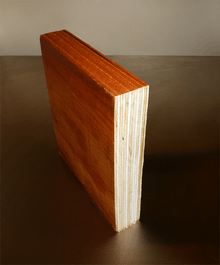Laminated veneer lumber

Laminated veneer lumber (LVL) is an engineered wood product that uses multiple layers of thin wood assembled with adhesives. It is typically used for headers, beams, rimboard, and edge-forming material. LVL offers several advantages over typical milled lumber: Made in a factory under controlled specifications, it is stronger, straighter, and more uniform. Due to its composite nature, it is much less likely than conventional lumber to warp, twist, bow, or shrink.
Laminated veneer lumber is similar in appearance to plywood without crossbands,[1] and is typically rated by the manufacturer for elastic modulus and allowable bending stress. Common elastic moduli are 1,800,000 psi (12,000 MPa); 1,900,000 psi (13,000 MPa); and 2,000,000 psi (14,000 MPa); and common allowable bending stress values are 2,800 psi (19 MPa); and 3,000 psi (21 MPa).
LVL is commonly manufactured in North America by companies that also manufacture I-joists. LVL is manufactured to sizes compatible with the depth of I-joist framing members for use as beams and headers. Additionally, some manufacturers further cut LVL into sizes for use as chord-members on I-joists. In 2012, North American LVL manufacturers produced more than 43.4 million cubic feet (1.2 million cubic meters) of LVL in 18 different facilities, and in 2013 the production increased with more than 14%.[2][3]
Because it is specifically sized to be compatible with I-joist floor framing, residential builders and building designers like the combination of I-joist and LVL floor and roof assemblies. LVL is a highly reliable building material that provides many of the same attributes associated with large sized timbers.
Structural composite lumber
LVL belongs to the category of engineered wood called structural composite lumber. Other members of this category are parallel strand lumber (PSL) and laminated strand lumber (LSL). All members of this category are strong and predictable, and are thus interchangeable for some applications.[4] PSL is made from veneers that are cut up into long strands and oriented parallel to its length before compressed into its final shape. LSL is also made from strands rather than veneer, although the strands are shorter and aligned with less precision than PSL and is created as billets that are like a thick version of oriented strand board.
See also
References
- ↑ Allen, Edward and Joseph Iano. Fundamentals of Building Construction: Fourth Edition. Hoboken: John Wiley & Sons, 2004. pg. 91
- ↑ Environmental Product Declaration for North American Laminated Veneer Lumber (PDF). American Wood Council. 12 July 2013.
- ↑ "North American panel output rises". Fordaq. Fordaq S.A. 3 March 2013.
- ↑ "All About Beams". Selkirk Truss Ltd. Retrieved 19 Nov 2008.